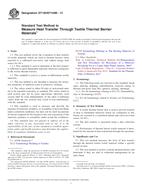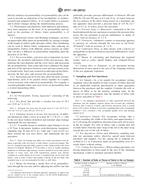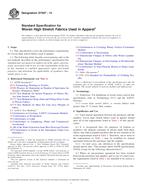Potřebujeme váš souhlas k využití jednotlivých dat, aby se vám mimo jiné mohly ukazovat informace týkající se vašich zájmů. Souhlas udělíte kliknutím na tlačítko „OK“.
ASTM D3514/D3514M-10(2014)
Standard Test Method for Pilling Resistance and Other Related Surface Changes of Textile Fabrics: Elastomeric Pad
Automaticky přeložený název:
Standardní zkušební metoda pro Žmolkovatění odporu a dalších souvisejících povrchových změn tkanin: Kaučukovitý Pad
NORMA vydána dne 1.7.2014
Informace o normě:
Označení normy: ASTM D3514/D3514M-10(2014)
Poznámka: NEPLATNÁ
Datum vydání normy: 1.7.2014
Kód zboží: NS-23911
Počet stran: 5
Přibližná hmotnost: 15 g (0.03 liber)
Země: Americká technická norma
Kategorie: Technické normy ASTM
Kategorie - podobné normy:
Anotace textu normy ASTM D3514/D3514M-10(2014) :
Keywords:
fabric, fuzz, pills, ICS Number Code 59.080.30 (Textile fabrics)
Doplňující informace
| Significance and Use | ||||||||||||
|
5.1 Acceptance Testing—This method of testing fabrics for resistance to pilling is not recommended for acceptance testing. If it is used for acceptance testing, it should be used with caution because interlaboratory data are not available. In some cases the purchaser and the supplier may have to test a commercial shipment of one or more specific materials by the best available method, even though the method has not been recommended for acceptance testing. 5.1.1 If there is a disagreement arising from differences in values reported by the purchaser and the supplier when using Test Method D3514 for acceptance testing, the statistical bias, if any, between the laboratory of the purchaser and the laboratory of the supplier should be determined based on testing specimens randomly drawn from one sample of material of the type being evaluated. Competent statistical assistance is recommended for the investigation of bias. A minimum of two parties should take a group of test specimens which are as homogeneous as possible and which are from a lot of material of the type in question. The test specimens should then be randomly assigned in equal numbers to each laboratory for testing. The average test results from the two laboratories should be compared using an acceptable statistical protocol and probability level chosen by the two parties before the testing begins. Appropriate statistical disciplines for comparing data must be used when the purchaser and supplier cannot agree. If a bias is found, either its cause must be found and corrected, or the purchaser and the supplier must agree to interpret future test results with consideration for the known bias. 5.2 The pilling of textile fabrics is a very complex property because it is affected by many factors which may include type of fiber or blends, fiber dimensions, yarn and fabric construction, and fabric finishing treatments. The pilling resistance of a specific fabric in actual wear varies more with general conditions of use and individual wearers than in replicate fabric specimens subjected to controlled laboratory tests. This experience should be borne in mind when adopting levels of acceptability for any series of standards. 5.3 Finishes and fabric surface changes may exert a large effect on pilling. It is recommended that fabrics be tested after laundering or drycleaning, or both. Testing before refurbishing may also be advisable. Prior agreement between interested parties should determine the state of test. 5.4 Pills vary appreciably in size and appearance and depend on the presence of lint and degree of color contrast. These factors are not evaluated when pilling is rated solely on the number of pills. The development of pills may be accompanied by other surface phenomena such as loss of cover, color change, or the development of fuzz. Since the overall acceptability of a specific fabric is dependent on both the characteristics of the pills and the other factors affecting surface appearance, it is suggested that fabrics tested in the laboratory be evaluated subjectively with regard to their acceptability and not rated solely on the number of pills developed. A series of standards, based on graduated degrees of surface change of the fabric type being tested, may be set up to provide a basis for subjective ratings. The visual standards are most advantageous when the laboratory test specimens correlate closely in appearance with worn fabrics and show a similar ratio of pills to fuzz. Counting the pills and weighting their number with respect to their size and contrast, as a combined measure of pilling resistance, is not recommended because of the excessive time required for counting, sizing, and calculation. 5.5 The degree of fabric pilling is evaluated by comparing the tested specimens with visual standards, which may be actual fabrics or photographs of fabrics, showing a range of pilling resistance. The observed resistance to pilling is reported on an arbitrary scale ranging from 5 (no pilling) to 1 (very severe pilling). 5.6 This test method is applicable to a wide variety of woven and knitted fabrics that vary in pilling propensity as a result of variations in fiber, yarn and fabric structure, and finish. The applicability of the test method to non-woven fabrics has not been determined. |
||||||||||||
| 1. Scope | ||||||||||||
|
1.1 This test method covers the determination of the resistance to the formation of pills and other surface distortions such as fuzzing of textile fabrics. The method utilizes the Stoll Quartermaster Universal Wear Tester with the frosting attachment. The procedure is generally applicable to all types of woven and knitted fabrics. Note 1: For other current test methods of testing the pilling
resistance of textiles, refer to Test Methods D3511, D3512, and D4970.
1.2 The fabric may be laundered or dry cleaned before testing. 1.3 This standard may involve hazardous materials, operations, and equipment. This standard does not purport to address all of the safety concerns, if any, associated with its use. It is the responsibility of the user of this standard to establish appropriate safety and health practices and determine the applicability of regulatory limitations prior to use. |
||||||||||||
| 2. Referenced Documents | ||||||||||||
|
Podobné normy:
Historická
1.6.2011
Historická
1.5.2011
Historická
1.9.2008
Historická
15.3.2013
Historická
1.7.2012
Historická
1.2.2014



 ASTM D6797-07(2011)..
ASTM D6797-07(2011).. ASTM D6828-02(2011)..
ASTM D6828-02(2011).. ASTM D6856/D6856M-03..
ASTM D6856/D6856M-03.. ASTM D7140/D7140M-13..
ASTM D7140/D7140M-13.. ASTM D737-04(2012)..
ASTM D737-04(2012).. ASTM D7507-14
ASTM D7507-14
 Cookies
Cookies
